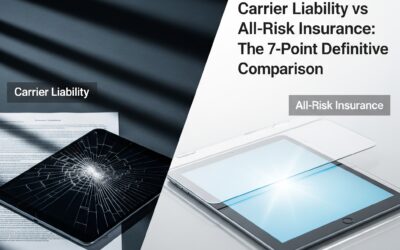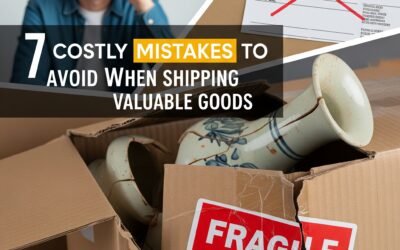Shipping anything can be a nerve-wracking experience. But when it comes to high-value items, the pressure really ramps up. One mistake, and your precious cargo could be lost forever. And that’s where high value shipping insurance comes in.
If you’re shipping artwork, electronics, or any other valuable product, choosing the right shipping partner is crucial. In this blog, we’ll guide you through the process of ensuring your high-value shipment arrives safely and securely. We’ll cover selecting a reputable carrier and the importance of insurance.
So without keeping your shipments at risk any longer, lets get your shipping protected!
What is Shipping Insurance and How Does It Work?
High value shipping insurance protects valuable items shipped domestically or internationally. It acts as a financial safety net for both individuals and businesses shipping expensive goods. In case of loss or damage during transportation, insurance provides compensation to repair or replace the item.
Essentially, you pay an upfront insurance cost in exchange for reimbursement if something goes wrong during shipping. This transfers the risk from you to the insurance company.
Benefits Of Shipping Insurance For High-Value Items
Valuable items during shipping can expose you to significant financial risk. Fortunately, purchasing high value shipping insurance offers several distinct advantages:
- Enhanced Peace of Mind
Insurance acts as a financial safeguard, mitigating potential losses and providing peace of mind. Regardless of whether your item is damaged, delayed, or lost during transit, insurance offers protection.
- Full Replacement Value Coverage
Traditional shipping carriers typically offer minimal compensation for damaged or lost goods. Insurance, on the other hand, can reimburse you for the complete replacement value of your item, eliminating any financial burden on your end.
- Global Protection
When shipping valuable items internationally, standard carrier liability is often limited. Insurance provides comprehensive coverage for your shipment, ensuring maximum protection throughout its global journey.
- Door-to-Door Coverage
Many insurance policies offer comprehensive coverage from the moment your item leaves your doorstep until it arrives at the recipient’s. This eliminates gaps in protection throughout the entire shipping process.
- Customizable Limits
You can tailor your insurance coverage to directly match the value of your shipment. Higher value items may necessitate more extensive coverage, which insurance readily allows you to adjust.
- Coverage for Minor Damage
Insurance doesn’t solely address major losses. It can also reimburse you for minor damage, such as a scratched case or a small tear – every bit counts when dealing with valuable items.
Factors Affecting Shipping Insurance Cost
When shipping goods, careful consideration of both shipping services and insurance policies is essential for safeguarding your products and minimizing financial risks. Several factors influence the cost of this coverage with different types of shipping insurances available, so it’s important to understand how each one can impact your final costs. Such key factors are –
- Value of Goods
The primary factor influencing insurance costs is the declared value of your shipment. Higher value goods naturally require more comprehensive coverage, resulting in a higher premium. To ensure full reimbursement for loss or damage, it’s crucial to declare the accurate value of your products.
- Shipment Distance
The length of your shipment’s journey directly affects pricing. Longer distances and extended transit times present increased risks, leading to higher insurance costs. Shipping things internationally usually costs more to insure than shipping them within your own country. This is because there are more rules and regulations to follow when shipping things across borders, and there’s a higher chance of delays. Also, if you choose to have your things shipped by airplane instead of by boat or truck, which is usually faster, the insurance will also cost more.
- Carrier Selection
The shipping companies you choose offer varying levels of inherent liability coverage. Picking a well-known shipping company with a good safety record gives you some insurance right off the bat, so you might not need as much extra coverage. If you’re shipping things overseas and need them to move smoothly between different countries, using a global company can make things easier and less likely to get lost.
- Cargo Type
Specialized handling and insurance policies are often required for hazardous materials, high-value items, or fragile goods. For example, shipping alcohol may involve additional taxes and restrictions. If you’re shipping live animals, they need to travel with specially trained caretakers and in vehicles designed for their comfort and safety. For perishable goods, like food or medicine, special trucks or airplanes that keep them at the right temperature are needed to prevent them from spoiling.
- Claim History
Insurance providers consider a client’s past history when setting premiums. Frequent or significant insurance claims can lead to higher premiums, similar to how auto insurance rates are adjusted based on a driver’s history. Keeping good records of your shipments and any past claims, and making sure any mistakes are fixed quickly, can help you get better rates in the future.
Important Things To Know For High Value Shipping Insurances
Once you’ve chosen to secure your valuable shipment with insurance, understanding coverage details and the claims process is essential. Here’s the important points to help you navigate these aspects and ensuring a smooth experience:
- Calculating the Right Coverage Amount
Choosing the right high value shipping insurance amount is critical. It should reflect the full replacement cost of your goods, including the initial purchase price and any delivery fees incurred. You may also want to consider including the potential profit you would earn from a timely delivery. Reviewing past shipping records and purchase receipts can help ensure you declare an accurate value. Remember, excessively high coverage just to be safe is unnecessary and will increase your insurance costs.
- Understanding Policy Details
It’s vital to thoroughly review all aspects of your shipping insurance policy. Pay close attention to exclusions, deductibles, maximum payout limits, and required documentation for claims. For example, some policies may not cover damage caused by inadequate packing materials unless packing was done by a professional. It’s also common for standard policies to exclude losses due to floods, earthquakes, or war.
- Balancing Premiums and Deductibles
Higher deductibles, the amount you pay upfront before insurance kicks in, will result in lower premiums. However, ensure you have sufficient funds readily available to cover these out-of-pocket expenses in case of minor losses.
Maximum claim payouts may be capped at a percentage of the declared value, rather than full reimbursement.
- Streamlining the Claims Process
Claims processing typically requires proper documentation, including proof of delivery records, photos of damaged goods, and repair estimates. Failing to provide these could lead to a claim denial. Taking the time to understand all policy conditions upfront can significantly smooth out the claims process and avoid any unexpected delays or frustrations down the road.
How to File a Shipping Insurance Claim?
Filing a shipping insurance claim doesn’t need to be a stressful experience. By carefully preparing and following established procedures, you can ensure a smooth and efficient resolution. The claims process is designed to protect both the customer and the insurance company, so organization and detailed record-keeping are essential for a successful claim.
Here’s a breakdown of the key steps involved:
- Gather Documentation
Collect evidence of your loss or damaged goods. This includes photographs of any visible damage, signed delivery receipts from the carrier noting the condition of the items upon arrival, and proof of your insurance coverage.
- Prompt Contact
Once you have this documentation assembled, contact your insurance provider within the timeframe outlined in your policy. This timeframe is typically between 3 and 10 days from the incident.
- Detailed Claim Filing
When filing the claim, provide a clear and detailed description of the lost or damaged items, along with a breakdown of their individual values. Be prepared to answer questions regarding the time and location of the loss. The insurance company may also request additional documentation such as purchase receipts, product specifications, or repair estimates. Cooperate fully with any investigation process – signing documented statements and allowing inspections can expedite the resolution of your claim.
How To Maximize Claim Approval For Your Insurance?
Several proactive steps can significantly increase your chances of a successful claim:
- Secure Packaging
Ensure your goods are carefully packaged to minimize the risk of damage during transport.
- High-Risk Items
If possible, avoid shipping items considered high-risk by insurance companies.
- Adequate Coverage
Purchase high value shipping insurance that adequately covers the full value of your shipment.
- Following Guidelines
Adhere to all carrier guidelines for packaging and labeling.
- Prompt Reporting
Report any problems with your shipment immediately upon discovery.
- Comprehensive Records
Maintain thorough records of your shipment, including purchase receipts, packing slips, and photos.
By following these steps and maintaining good documentation, most legitimate claims can be settled efficiently and without undue stress.
Conclusion
When you’ve invested hundreds or even thousands of dollars into shipping valuable items, wouldn’t you want to safeguard that investment? Unfortunately, mishaps during shipping are a daily reality. Because a package can get damaged, lost, or even stolen, entirely outside of your control. As a seller or collector of high-value goods, the last thing you want is for your prized possessions to be ruined in transit. And ultimately leaving you with the burden of replacement costs.
Shipping insurance is like a safety net for your valuable items. For a small fee compared to how much your stuff is worth, high value shipping insurance takes away the worry of wondering if your shipment will make it safe and sound. Insurance could save you a lot of money if something goes wrong, and give you peace of mind knowing your stuff is protected.
So, don’t let shipping worries cloud your valuable transactions! Get that high value shipping insurance and start living a worry free life!
FAQ
What Is High-Value Shipping?
In the world of shipping, items valued at $100,000 or more are considered high-value. Because of their importance, extra care is needed to ensure they arrive safely at their destination.
What Is Shipment Insurance Value?
When shipping valuables, insurance protects your goods from loss, damage, or theft during transport. While most carriers offer some basic coverage, it’s typically based on the weight of your shipment, not its actual value. This means you might not be fully reimbursed if something goes wrong.





